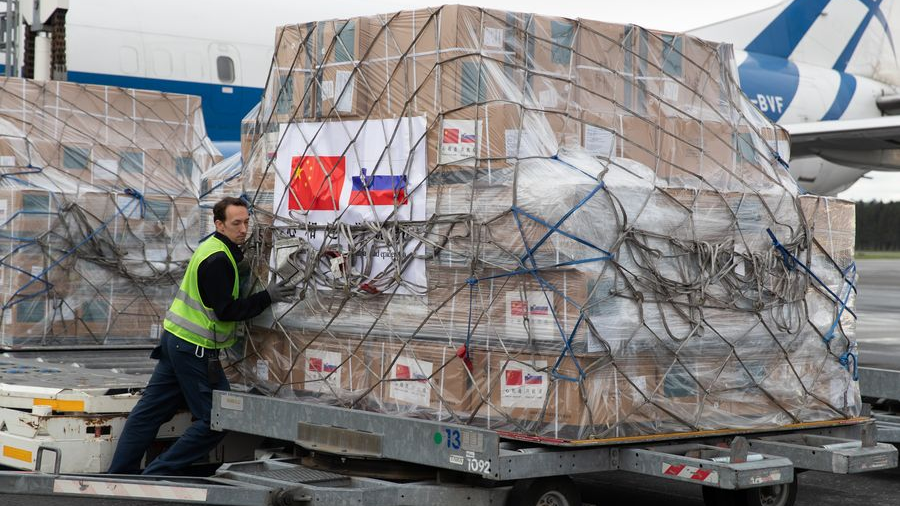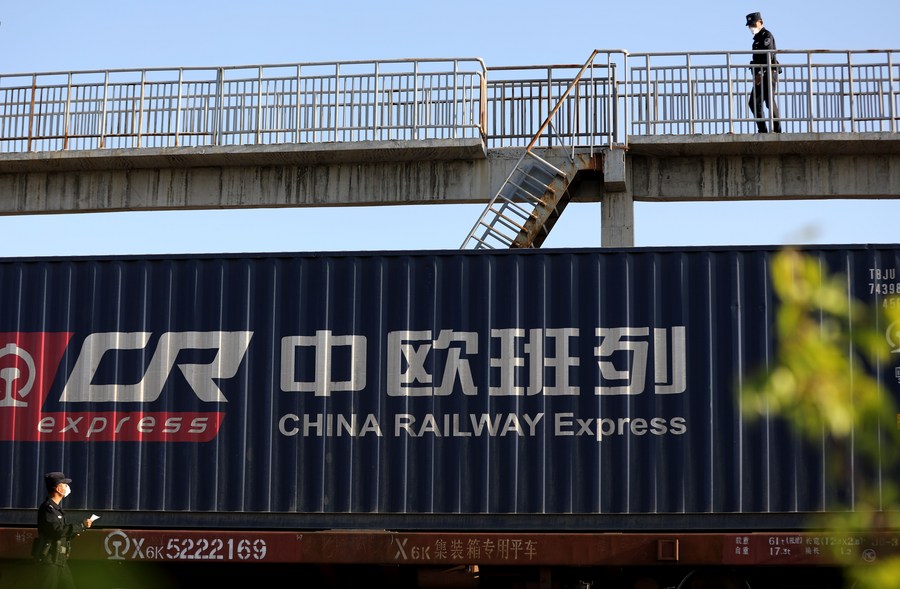
An airport staff member unloads Chinese medical supplies in Ljubljana, Slovenia, May 1, 2020. /Xinhua
An airport staff member unloads Chinese medical supplies in Ljubljana, Slovenia, May 1, 2020. /Xinhua
Editor's Note: Seymur Mammadov is the director of the international expert club EurAsiaAz and editor-in-chief of Azerbaijan news agency Vzglyad.az. The article reflects the author's opinions, and not necessarily the views of CGTN.
The coronavirus pandemic that has paralyzed the world is hitting the economies of developing countries. More than 150 countries have already turned to the International Monetary Fund and the World Bank for help. This will be a test for the organizations, which are called upon to maintain the stability of the global economy.
On the one hand, we see how the economic crisis is deepening. On the other hand, tensions are growing in relations between the Eurasian countries.
During the pandemic, armed conflicts flared up in the hot spots of Eurasia. For example, an escalation of conflict happened on the Armenian-Azerbaijani border, which led to the death of at least 16 people.
The risks are many and there is a possibility that there will be even more. Therefore, to minimize existing risks and suppress potential risks, it is necessary to "turn risks into opportunities" — this is the creation of a more favorable environment for multilateral economic cooperation between Eurasian countries, which can definitely lead to an increase in the level of security and a decrease in tension in relations between Eurasian countries.
By launching a sizable economic platform, using economic instruments, effective results can be achieved. The Belt and Road Initiative (BRI) proposed by China can serve as such a platform during the pandemic and post-pandemic era. China, in fact, may well become the locomotive of a new post-pandemic economic order.
Today, risks in the form of inter-ethnic and interstate conflicts in Eurasia have loudly declared themselves, but the willingness to work together can be the first step in reducing tension in relations between the Eurasian countries and their gradual recovery from the economic crisis induced by COVID-19.
In this regard, China has a special responsibility as many of the Eurasian countries participating in the BRI look forward to further expanding multilateral cooperation within the framework of the initiative in the post-pandemic period.
Belt and Road partner countries and countries that are reluctant to participate in the initiative are all looking for new opportunities and ideas to revitalize their economies, to complete projects suspended due to the pandemic and implement new infrastructure projects.

A policeman checks an outbound China-Europe freight train at Horgos Pass in northwest China's Xinjiang Uygur Autonomous Region, April 20, 2020. /Xinhua
A policeman checks an outbound China-Europe freight train at Horgos Pass in northwest China's Xinjiang Uygur Autonomous Region, April 20, 2020. /Xinhua
For example, the Ministry of Infrastructure of Ukraine has requested a loan from the Azerbaijani government for the implementation of infrastructure projects in the field of transport. Moreover, the request was sent against the background of the recently provided financial assistance to Kiev by the European Union in the amount of 1.2 billion euros.
In fact, there are many more countries, including European ones, that need loans to revive their economies than you might imagine. There is an explanation for this: the GDP of the European Union (EU) countries in the second quarter of 2020 fell by a record 14.4 percent in annual terms. In the EU countries themselves, not everything is going smoothly with the financing of the economic recovery plan. Some are facing severe depletion of their domestic reserves. And the funds allocated by the EU to support the economies of member states are not sufficient to compensate for the losses from the coronavirus pandemic and from the decline in oil prices.
During the pandemic, BRI-participating economies were in a better position. In the first four months of 2020, the foreign trade turnover between China and the countries along the Belt and Road reached 2.76 trillion yuan, an increase of 0.9 percent on an annual basis, according to China's General Administration of Customs. Meanwhile, according to China's Ministry of Commerce, Chinese enterprises in the first four months of 2020 invested 4.2 billion U.S. dollars in 52 BRI-participating countries, an 11.7-percent increase over the same period a year earlier.
The Belt and Road transport corridors, ports and logistics centers have benefited the countries participating in the initiative by providing medical assistance to partner countries in need of support during the pandemic. This shows that the interconnected routes continue to maintain their main functions, namely, to provide uninterrupted communication between China and other countries of the world.
The COVID-19 pandemic has once again proven the close connection between the destinies of all states and the need to create a "Health Silk Road," which the BRI has indicated as a new area of cooperation.
During the period of prevention and control of the pandemic, the important role of China-Europe international rail freight was once again revealed, serving as an important logistics line in China's trade cooperation with countries along the Belt and Road. "China-Europe" freight trains from Xi'an, China to Izmit, Turkey cover 6,437 kilometres in just 12 days, cutting the time of transportation of goods by almost half compared to sea transportation.
To improve rail freight services on China-Europe routes, China has allocated 200 million yuan (about 28.3 million U.S. dollars) to support the construction of transportation hubs in its five cities.
Having passed the test of the coronavirus pandemic, the international cooperation of countries within the BRI framework will become even broader, more diverse and more sophisticated. In the post-pandemic period, the attractiveness of the initiative will only increase. Because if it continues to be implemented and benefits partner countries in a pandemic, then after the final victory over the virus, some countries that have not recognized the success of the BRI in the past and have stayed away from it may reconsider their relations with China and join the idea of building a multipolar world. It doesn't take long to wait.
(If you want to contribute and have specific expertise, contact us at opinions@cgtn.com.)